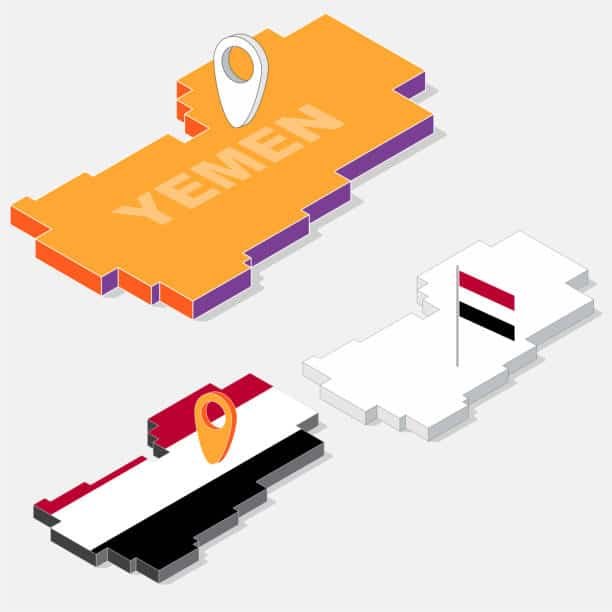GWT Worldwide – professional shipping to Yemen involving China. Air freight, sea freight, express delivery services & customs clearance services. Receive protecting China-Yemen logistics charges with skilled assistance.
Über GWT Worldwide - Ihr zuverlässiger Logistikpartner
GWT Worldwide is a logistics professional service provider dedicated to international freight forwarding, supply chain management and cross-border e-commerce logistics. Being well established in China and global markets, we believe in providing quality, affordable, and specialized logistic solutions to companies all over the world.
At GWT Worldwide we work on the efficiency, transparency, and customer satisfaction. We combine sophisticated logistics technology and a world-wide network of reliable partners to make sure that your goods will travel safely, faster and in compliance with all relevant regulations, origin to destination. GWT Worldwide is your reliable logistics associate whether you are a small business or a large-scale importer/exporter to conduct hassle-free international business.
Comprehensive Shipping Services from China to Yemen

Air Freight Solutions
Express and effective Luftfracht solutions between leading cities of China and main destinations in Yemen such as Sanaa and Aden. Our air freights services offer:
- Expedited shipping of time-sensitive cargo
- Combined cargo services to achieve cost effectiveness.
- Options of door to door deliveries
- Live tracking and information
Sea Freight Services
Economical ocean transportation services on bigger consignments and bulk goods:
- Full Container Load (FCL) services
- Less than Container Load (LCL) services
- Port- port and door-door delivery
- Special rates on general freight.
Internationale Express- und Kurierlösungen
Priority express document and small package services:
- DHL FedEx UPS alliances.
- Delivery times 3-7 days
- Safe transportation of sensitive files
- Tracing during transit
Our Complete Service Portfolio
Air Freight & Seefracht Our broad shipping services fit your schedule and budget needs.
China Europe Railway Transport Alternative land based shipping solutions to particular cargo requirements.
International Express & Courier Solutions Urgent delivery of documents and parcels.
Customs Clearance & Warehousing Expert Unlike other companies, we have an expert in all customs formalities and have secure warehouses.
Amazon FBA Shipping & Labeling Support E-commerce business and Amazon seller specialized services.
Why Choose GWT Worldwide for China-Yemen Shipping?

Expertise in Yemen Market
Our team is aware of the particular needs and complications of shipping to Yemen, which include:
- Local regulations and procedures-customs.
- Documentation requirements
- Port and airport handling practices
- Business and cultural concerns
Reliable Network
Well established connections with reliable carriers and agents give you the guarantee that your cargo will arrive safely in Yemen and in time.
Competitive Pricing
We have clear, competitive prices with no extra charges, which allow you to streamline your logistics expenses.
End-to-End Service
We take care of all your shipment details, professionally, right after pick up in China to the final delivery in Yemen.
Get Your Quote Today
Prepared to ship in China to Yemen? Get in touch with GWT Worldwide to receive an individual quote and logistics advice of the experts. With our expert team, we will guide you through the maze of shipping across borders and get your commodities to their destination effectively and safely.
Get in touch with us today and get assured shipping services between China and Yemen.
1. Overview of China-Yemen Trade

China and Yemen trade relations indicate a major economic association, as Chinese exports to Yemen will reach up to US$2.68 billion in the course of 2023. This large volume of trade goes to show that there is an increasing demand of Chinese products in the Yemeni market and efficient shipping solutions are very essential to businesses that are involved in this trade route.
Principal shipping routes between Chinese ports and Yemen mainly deploy the Red Sea route via the Suez Canal. The Chinese exit points are majorly Shanghai, Shenzhen, Ningbo, and Qingdao, while the usual destination of the good is the major Yemen ports of Aden and Hodeidah. Regional conflicts however have had a great toll over these conventional routes and the Suez Canal experienced a 50 percent reduction in the volume of trade in early 2024 as compared to the same period the previous year.
The main products imported into Yemen (common goods) are textiles and garments, electronics and electrical equipment, machinery and industrial equipment, construction materials, automotive parts and vehicles, home appliances, and consumer goods all of which are imported into China. The products are the mainstay of Yemen importation needs with China in terms of supporting commercial and infrastructural development needs.
The effect of regional scenarios on the shipping activities cannot be overemphasized. Recent geopolitical conflicts in the Red Sea area have compelled a large number of shipping firms to take their vessels via the Cape of Good Hope, which adds several days and huge expenses to their transit duration. This change has a major effect on international trade having higher delivery schedules, delays, increases in prices and rising freight charges.
2. Shipping Methods
Seefracht
The most affordable mode of transport when shipping bulky goods in China to Yemen is sea freight. Full Container Load (FCL) services suit the needs of the business that export 15 or more cubic meters of cargo, as it is more secure and faster to pass through customs. Less than Container Load (LCL) services can take care of smaller loads, and several shippers can share the container space, decreasing the expenses.
Transit times through the Red Sea route are usually 15-25 days but with the present tensions in the region, it might take 30-45 days as the vessels have to deviate through the Cape of Good Hope. Sea freight specifically fits heavy machinery, bulk commodities, construction materials and non urgent consumer goods.
Luftfracht
Air freight is the quickest transportation option, and it takes 3-7 days to ship goods by air and deliver them to Sana a International Airport or Aden International Airport when departing the major Chinese airports. This is best when dealing with urgent consignments, high value items, perishable items and small packages where speed is more important than the cost.
Although air freight is by far more expensive than sea freight, it has its benefits such as lower insurance premiums since transit time is shorter, less handling needed, and the ability to track the shipment easily. Electronics, medical supplies, fashion shipments, and emergency shipments are frequently flown using air freight.
Rail-Sea Combined Transportation
China-Europe freight train network includes the innovative option, which is the rail transit via Central Asia and the sea transportation of the final leg of the journey to Yemen. This multimodal solution offers a compromise between ocean and air transportation in both price and delivery time.
Rail-sea combined transport has a usual delivery time of 20-30 days and some of its benefits are; it has less reliance on conventional sea routes, it is cheaper than air transportation, and it is more secure because of diversified routing. It is an effective approach to medium-priority shipments and offers resilience to the supply chain in case of regional disruptions.
3. Documentation Requirements

The documentation in shipping to Yemen is quite important. These are: Commercial Invoice: This document contains all the details relating to the goods that are being imported or exported such as the value, quantity and the country of origin.
Essential documents include:
- Commercial Invoice: Should describe goods, quantities, unit prices, total value and terms of sale
- Packing List: Detailed list of all the contents in the consignment including weights and dimensions
- Bill of Lading (B/L): Is a receipt of goods and a contract of carriage
- Certificate of Origin: Goods must have a certificate of origin to enjoy a preferential tariff treatment.
- Insurance Certificate: Evidence of coverage of cargo insurance
- Import License: Goods that are restricted or controlled goods need to have an import license.
Other documentation can be inspection certificates of certain goods, halal certificates of foodstuff and technical specifications of machinery or electronics. All the documents should be correct, similar, and well authenticated to prevent customs delay.
The language requirements indicate that the documents must be in English or Arabic and the Chinese only documents must be accompanied by certified translation. All paperwork must be kept in digital copies to ease reference during clearance.

4. Customs Clearance Process
The customs clearance procedure in Yemen is based on international practice with certain local specifications. Another concept that has evolved due to the works of the Customs Administration to cope with the growing amount of goods exchanged between the countries is the Authorized Economic Operator.
Pre-arrival: shipping documents must be submitted to the customs at least 24 hours prior to arrival. To speed up the process electronic pre-clearance systems are being used, although it is still possible that specific types of goods will have to be verified manually.
The physical inspection procedures depend on the assessment of risk with routine inspection of documents to check their conformity with the goods and description declared and assessment of the valuation to determine the duty to be paid. Synthetics or first-time importers can be subjected to increased scrutiny.
Duty and tax computation is based on the customs tariff of Yemen; this is closely dependant on the type of product. The custom tariff is normally between 5-25 percent and other taxes imposed are value-added tax and some levies on particular commodities. Goods release must be done after payment is made.
The typical clearance time frame is 2-7 days on standard shipments, but it may be longer in case of complicated cases or problems with documentation. Engaging the services of local customs brokers with experience would greatly cut the time of clearance and also help to meet the local regulations.
5. Logistics Considerations

The existing regional conflicts are a problem to port infrastructure in Yemen. Aden Port is conditionally functional with a reduced capacity, and the work of Hodeidah Port is restricted. Some shipments may have to be routed via other countries in the region such as Oman or Saudi Arabia.
Ports to final destination transportation over land has to be properly planned. The state of roads within Yemen differs greatly with places of security issues. Safe andTime delivery to inland destinations is only possible with reliable local logistic partners.
Major cities offer warehousing and storage facilities which can be used on a temporary basis but the capacity and security levels are not standard. There is a Climate controlled storage which is limited and thus it is considerate to check on the environmental factors when storing sensitive goods.
The issues associated with the last-mile delivery are a lack of infrastructure (especially in rural territories), security checks that can slow down the process, and the necessity to use the local knowledge to deal with the regulatory environments. It is important to build connections with reputable local partners in order to distribute it well.
6. Challenges in Yemen Shipping

The major issue is security concerns where regional conflicts have an impact on the shipping routes and activities in ports. The latest sourcing of commercial vessels in the Red Sea by Yemeni Iran-sponsored Houthi militants has diverted commerce out of a key trade route in consumer products and energy resources.
Under infrastructural constraints we have dilapidated port infrastructure, scarce cargo handling facilities and undependable power. Such limitations may produce delay and add handling expenses, necessitating contingency preparations and adaptable scheduling.
Regulatory complexity is caused by changes in import regulations, the number of approvals that have to be obtained on some goods and documentation requirements that can change with political events. The compliance requires keeping abreast with the current requirements.
Issues of payment and financing: Banking infrastructure is limited, there is foreign exchange restriction and there is the credit risk due to political instability. The mitigation of risks requires secure payment options and adequate insurance cover.
7. Cost Factors
The fundamental shipping prices can differ greatly depending on the shipping technique, where a 20ft container by sea could price anywhere between $800-2,000, air freight charges around 4-8 dollars per kilogram, whilst rail-sea combined services are between these two extremes. The ongoing tension in the region has seen conventional Red Sea routes raising by 100-200 percent.
Other charges are fuel surcharges which vary with the price of oil, security surcharges on high-risk routes and documentation fees of $50-200 per shipment. During peak seasons there can be port congestion fee and equipment surcharges.
The cost of insurance is usually 0.1-0.5 per cent of the value of the cargo in the case of sea freight and 0.05-0.2 per cent in the case of air freight. Red Sea routes may require war risk insurance, which increases the cargo value by 0.1-0.3 per cent. Because of the risks in the region, it is advisable to have comprehensive coverage.
Such hidden costs may be demurrage (container detention) charges, storage costs at the destination ports and customs inspection charges. These additional costs are reduced by adequate planning and through the services of skilled freight forwarders.
8. Working with Freight Forwarders

When choosing freight forwarders, such selection criteria as experience in working with China-Yemen routes, developed network in both countries, a full range of services and financial stability should be taken into account. There is added assurance through references by other businesses as well as industry certifications.
The scope of the services provided is normally export documentation preparation, customs clearance, cargo insurance, and shipment tracking services. Warehousing, distribution and supply chain consulting are also offered by the full-service forwarders.
Communication procedures must be set up with definite contact points, routine status reports and emergency communication systems. Language choices in Chinese, English as well as Arabic assist in the ease of operation among all the stakeholders.
Performance monitoring entails the following of important metrics such as on-time delivery performances, accurateness of documentation, cost clarity, and the rate of resolving problems. Reviews on a regular basis help to maintain the service levels as per the business needs and also improve on areas that need the attention.
9. Shipping Regulations and Compliance

Chinese laws on export stipulate that exporters must comply with the Chinese customs, obtain an export license of controlled items, and observe international trade sanctions. The products can be subject to quality checks or safety certifications prior to exportation.
Yemen import regulations prohibit and restrict certain imports, require licensing of certain groups of imports, and local technical standards. The restricted items list is quite dynamic and it is always better to check before shipping.
International compliance International compliance relates to the International Maritime Organization (IMO) compliance, dangerous goods shipping compliance and international trade sanctions. Ongoing compliance requires regularly updated information on any regulatory changes.
Documentation compliance- this involves proper classification of products with Harmonized System (HS) codes, appropriate customs valuation, and keeping of adequate shipping documentation. Failure to do so may lead to fines, detention, or capture of cargo.
10. Best Practices for Successful Shipping

The preparation and planning must start with the well-conducted market research, established relationships with the trustful partners, and the extensive knowledge of the regulatory requirements. Alternate routing and contingencies can be made when there is early planning.
The risk management measures comprise the diversification of shipping routes, extensive insurance cover, as well as frequent contact with local partners. Considering the political risk insurance might be a worthy idea due to the instability in the region on the high-value shipments.
Quality control considerations will see to it that goods are well packaged to withstand long transit time, well documented to avoid delays and quality check before goods are shipped. These measures minimize the risks of claims and customer dissatisfaction.
Establishing relationship with local customs brokers, freight forwarders and logistics partners will help in smoother operations and quicker resolution of problems. The benefits of a long term partnership include preferential treatment and higher service levels.
11. Conclusion
The China to Yemen shipping offers great opportunities and challenges too. A huge level of trade at 2.68 billion shows how significant the market is but regional conflicts and infrastructure constraints necessitate a careful approach. This will only be successful when adequately planned, with tried and tested partnerships, and flexible strategies to consider changing conditions in the region.
Companies have to weigh price concerns against security and reliability needs, and in many cases alternative routing and full insurance coverage may be necessary, at higher cost. The operations are the key to success in working with experienced freight forwarders, flexible supply chains, and keeping up with the changing political and regulatory environment.

